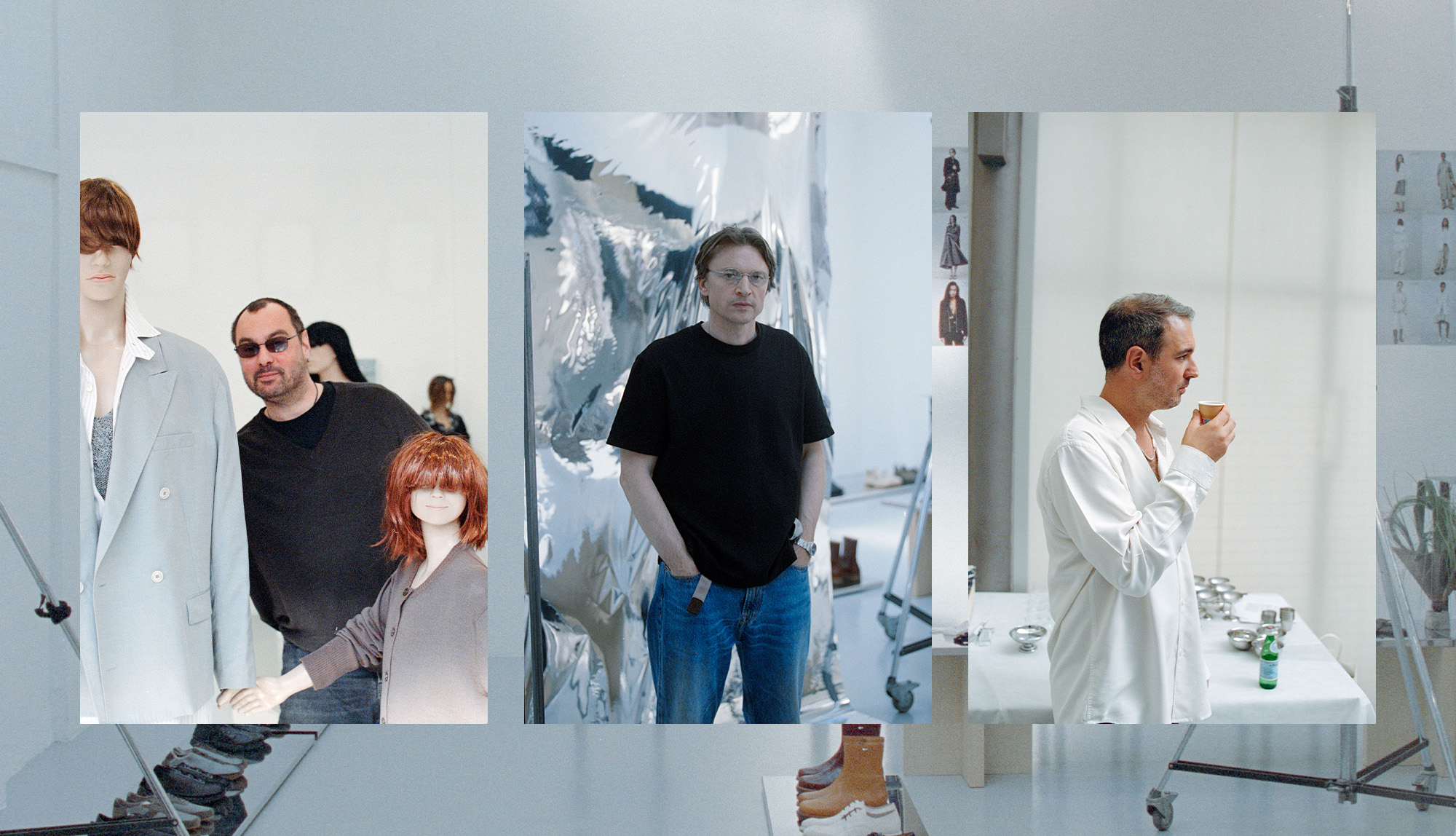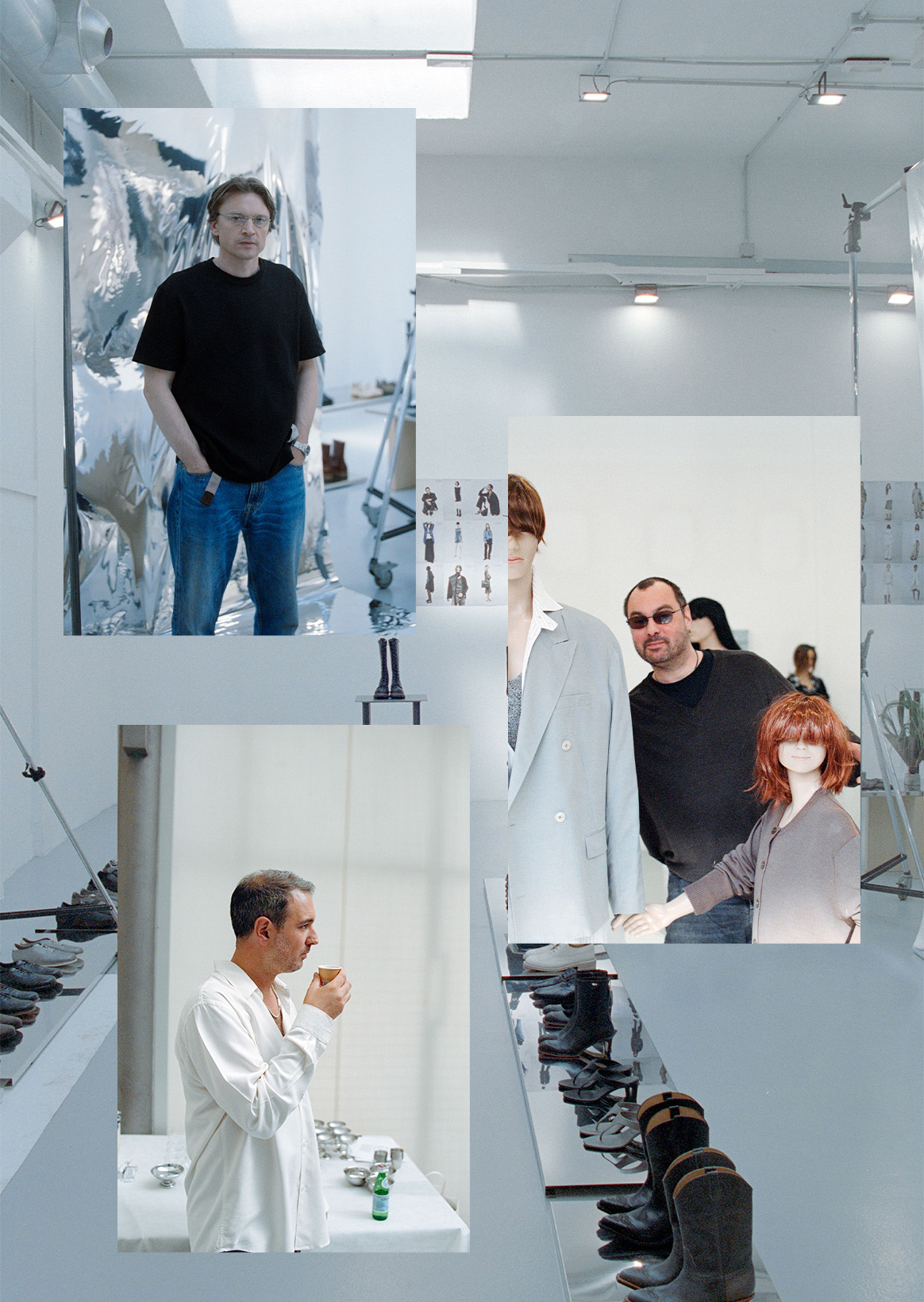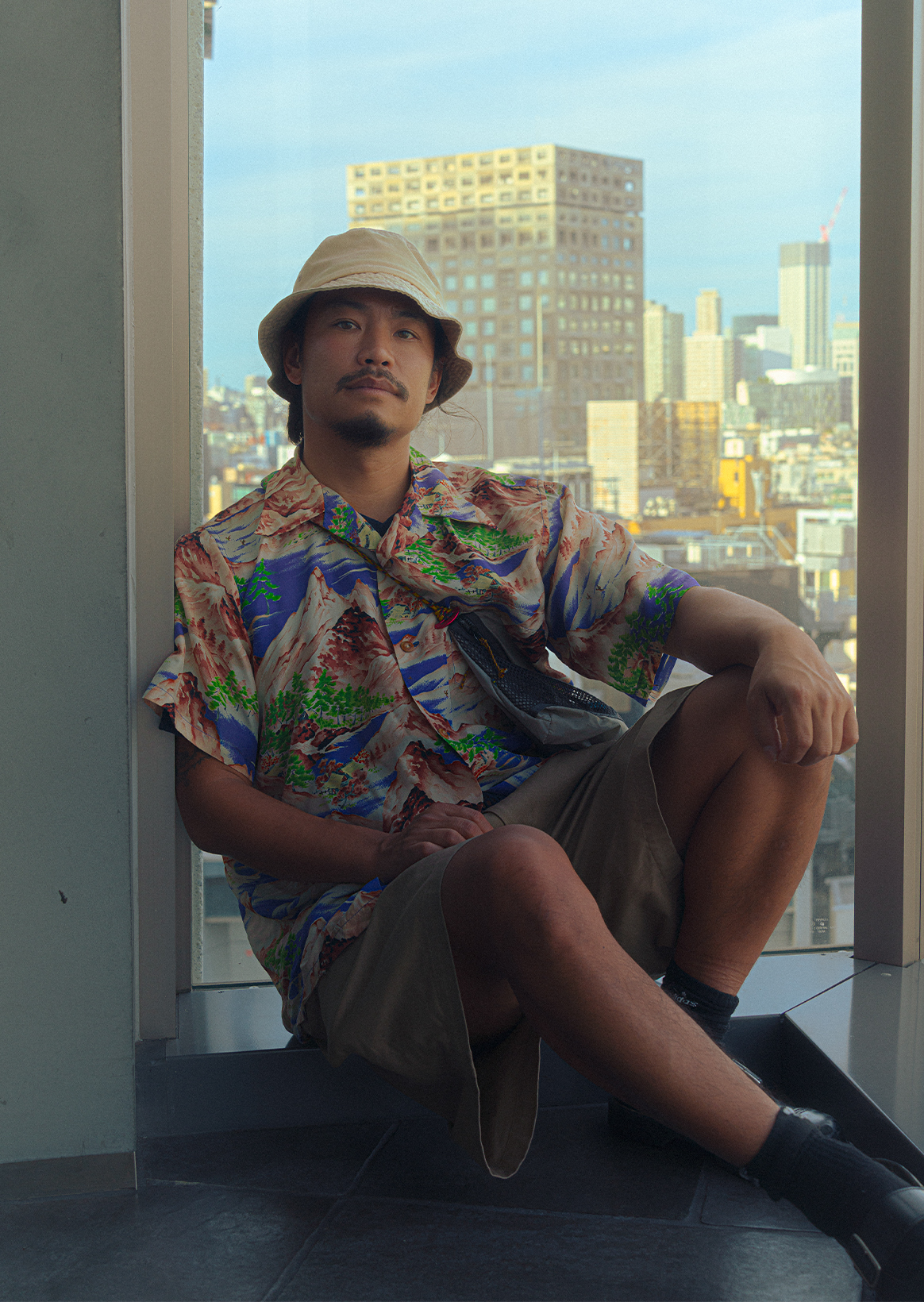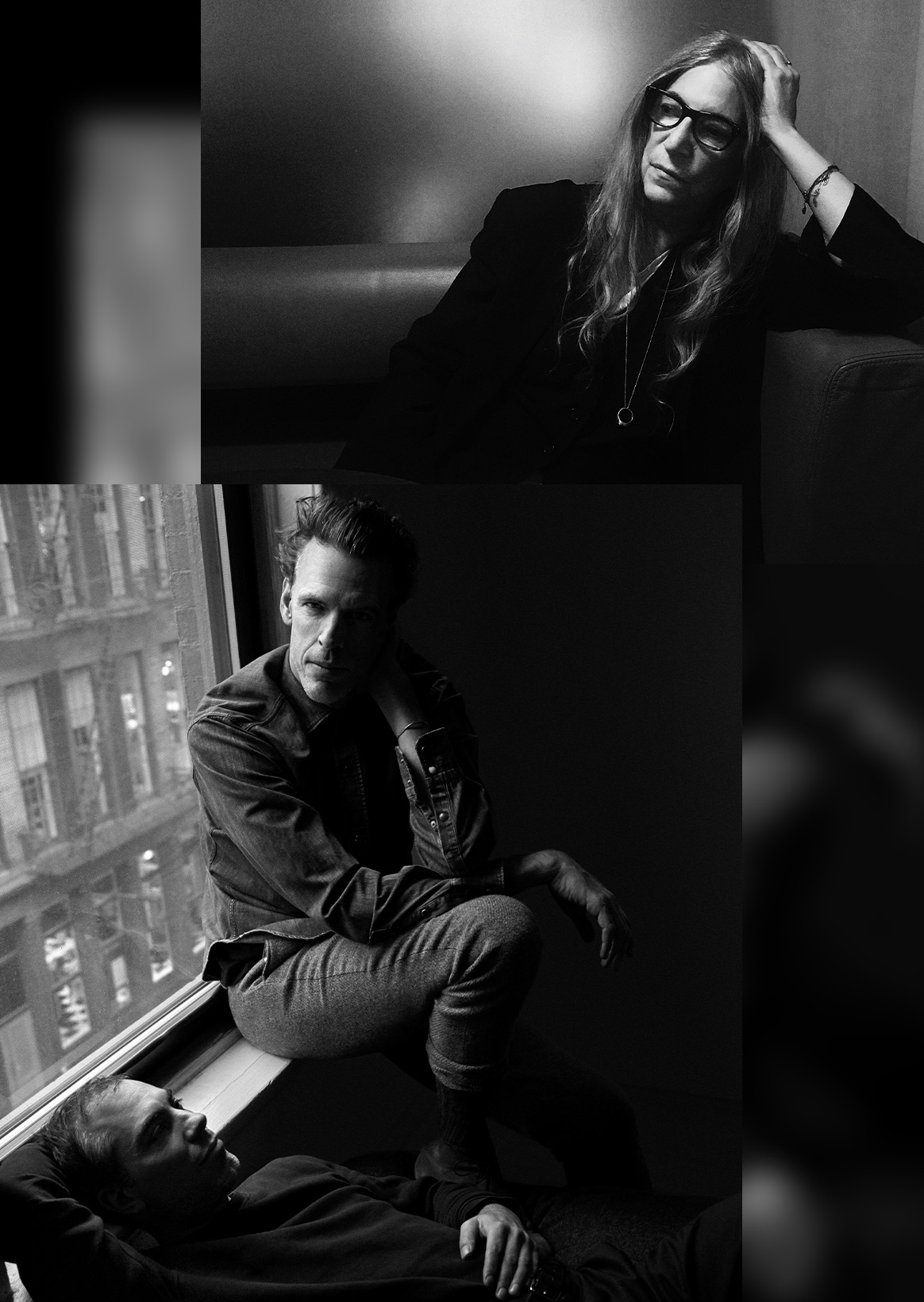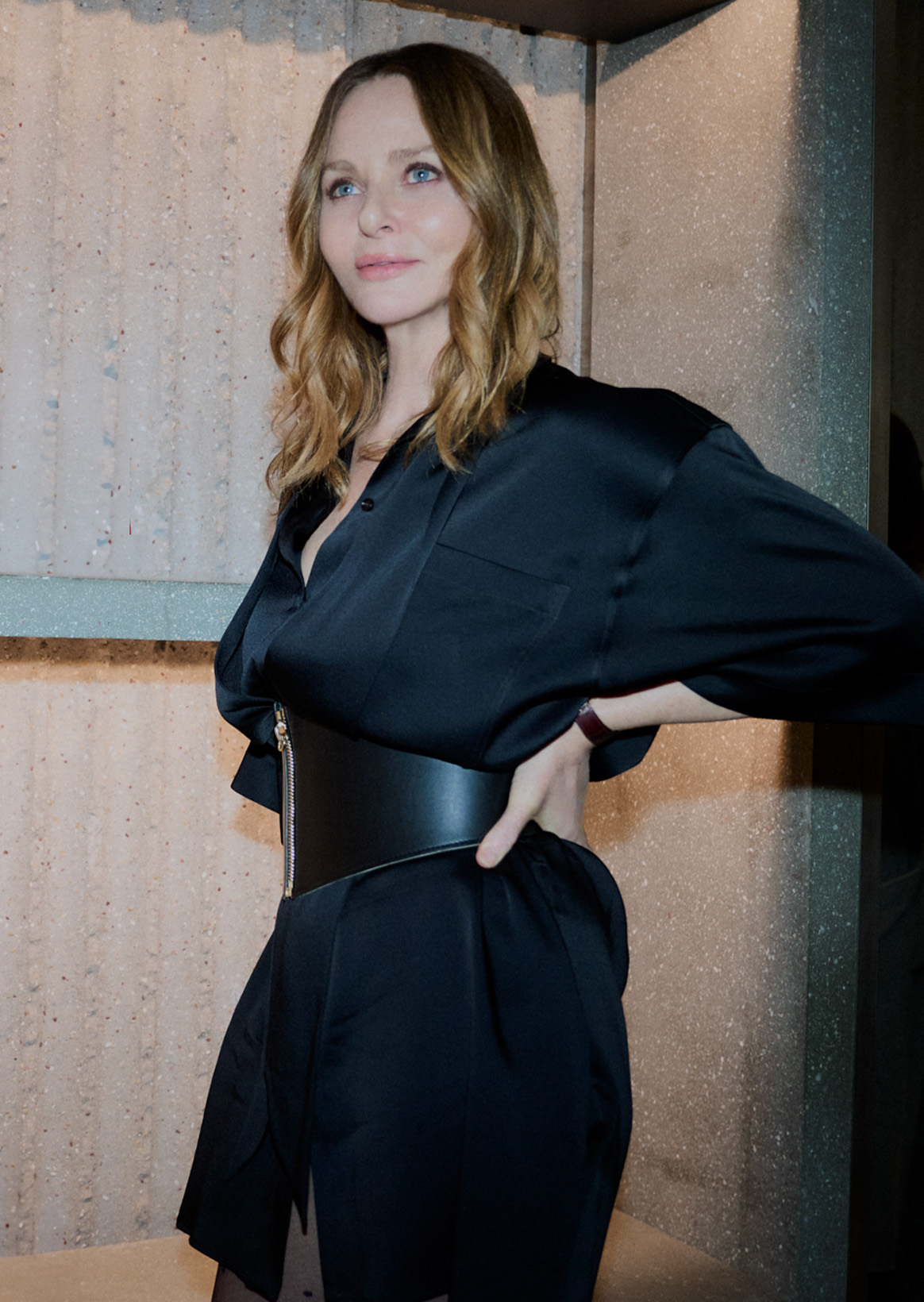10多岁时通过冰球相遇并成为朋友的约克姆·哈林和克里斯托弗·尼英,2005年在斯德哥尔摩成立了“OUR LEGACY”,不久之后理卡多斯·克拉伦也加入了该公司的共同经营者。近20年来,受音乐、滑板和艺术书籍等街头文化的影响,感性超越了现有时尚的框架,不断创造探索可持续性的表达方式。2025年6月13日,在涩谷PARCO 2楼盛大开业了日本第一家商店in Shop。从2016年开始,考虑到可持续性,WORK SHOP的项目也在展开,再利用死库存、样品和再利用材料的项目。通过服装的表现,创造的原点,以及从东京得到的灵感——。在这次的邮件采访中,我们将揭开他们的历程和对创造的哲学。
※ The English version is available below.
- Photo
- Nils Junji Edström
- Text
- Tomoko Ogawa
- Edit
- RIDE Inc.
 Jockum Hallin
Jockum Hallin  Cristopher Nying
Cristopher Nying  Richardos Klarén
Richardos Klarén
——约克姆·哈林和克里斯托弗·尼恩在10多岁的时候通过冰球相遇的时候,彼此都有什么样的印象呢? 如果当时度过了怎样的10多岁,现在还残留在自己心中的部分的话,请告诉我。
13岁时与 约克姆·哈林(以下简称约克姆)克里斯托弗相遇。在少年的冰球练习中,太擅长的他,升格为我年长的队伍。我是1980年出生的,他是1981年出生的,所以年龄很近,但是那个时候的我已经沉迷于音乐、滑雪板、滑板等塑造自己的东西,渐渐远离曲棍球。我自己开始打曲棍球很晚,为了抓住住处拼命努力着吧。另一方面,克里斯托弗作为一颗充满能量的新星来到了球队。这种态度现在也是一样的。见到他的人,一定会被他的毅力、能量和好奇心所震惊。他是一个不断前进的人,从以前开始就没有改变。
克里斯托弗·尼恩(以下简称克里斯托弗)一起打曲棍球,第一次见面是在巴士里。约克姆是一个沉稳、帅气、沉迷于音乐的时尚人,这是他最初的印象。这种印象一直没有改变。
——第一次感受到创造的喜悦是什么样的时刻?
克里斯托弗最初是画油画,制作雕刻的。关于西服,16岁的时候,在当地的福斯克瓦纳和朋友一起实验牛仔裤是开始的。用绳子把牛仔裤系在车后面,拖在泥上造成了伤害。之后,穿着牛仔裤洗了澡,进了桑拿晾干了。我至今还记得当时的兴奋感。
ー对于通过衣服向他人说明、表达自己的重要性,你是怎么想的?
在乔克姆年轻的时候,衣服在寻找自己的身份和住所方面起着很大的作用。衣服不需要说明,可以代表自己。这样一来,人就会靠近或离开,成为寻找朋友和朋友的契机。长大后,衣服仍然是自我表现的手段。你是想给你看一个整洁的人,还是想让你自由、有创意的人看?衣服是一个强大的工具,这一点没有改变,但是随着年龄的增长,他们的关系也在一点点地变化。
——你认为为了继续实现自己真正想做的事情,需要什么? 另外,为了成为能够做到这一点的自己,锻炼了你的经验是?
克里斯托弗对我来说,平面设计是一个很大的入口。学会了往返于物理制作和数字制作之间,这种平衡感成为了使形象成形的手段。这在制作衣服和用视觉表现感情的时候也很有用。而且,总是给我刺激的是书。特别是艺术书籍和写真集,自古以来就一直让我兴奋不已。
——千奈美培育自己的艺术作品是? 那时候,你唤起了什么样的感觉呢?
克里斯托弗马塞尔杜尚对作品的看法受到了很大的影响。他对作品非常有情感,其自由令人印象深刻。当斯德哥尔摩策展人复制在纽约发表的作品时,他不但生气,反而肯定地说“不是很好吗?”谁都可以复制自己的作品这样的想法,虽然引起了争议,但还是非常开放的思想。签名的代表作“R.Mutt”的马桶很有名,笑起来,但是他自己最喜欢的是在展示中没有人注意到的梳子。受到了这种没有边界的强烈影响。现在也提醒我对创作的自由态度。



我认为,正因为OUR LEGACY以拥有不同背景的成员而不是时尚,所以在时尚行业中,我们已经建立了一个既是塑料又独特的、渐进的、可持续发展实验的场所。继续建立这样的场合的秘诀是什么?
我想 约克姆正是那样。公司长大后,阶级钥匙和决策的结构是必要的,但是我们同时重视开放民主的工作方式。不是谁想的,而是经常保持着“最好的想法获胜”的姿态。气氛非常放松,是一个家庭式的职场。互相帮助,愉快地工作。因为时尚很有趣。服装、食物、葡萄酒、体育、艺术、摄影、音乐……能被那样的东西包围着工作真的很幸福,那个快乐表现在公司的气氛和伙伴意识上。
在变奏曲中,哪些是灵感的源泉?
克里斯托弗通常是从冲突中产生的。有些东西走投无路,可是突然一瞬间想起了想法。洗澡的时候或者做饭的时候突然,感觉很沉迷。不要错过那一刻。接下来是艺术书籍和写真集。从以前开始就读过好几次同一本书,每次都会有新的发现。不是在寻找,而是自然而然的。对我来说,创造性并不是强迫创造出来的。
——从开始WORK SHOP以来,OUR LEGACY的重要举措之一,您学到了什么? 请让我听听在推进约10年“尽量不扔垃圾就做衣服”哲学的过程中面临的课题和新的发现。
约克姆WORK SHOP对我们来说是非常重要的,是OUR LEGACY生态系统中不可或缺的一部分。主线和WORK SHOP相互起作用,其中一方是不成立的。最大的挑战是与大公司合作。我们虽然很小很轻松,但是大公司无论如何行动都很慢。好像是把油轮换个方向。但是我们坚持不懈地努力着,这种态度会给合作伙伴企业带来积极的影响。活用现有的材料,找到新的可持续解决方案是很难的,但相应地有很大的价值。

虽然在硅石、纹理和衣服中有过去的记忆,但OUR LEGACY似乎通过“重新诠释”创造了新的背景。对于怀旧和非怀旧的平衡您是怎么想的?
克里斯托弗我自己也不觉得太怀旧了。也许这是穿衣服的人和看的人所感受到的吧。对我来说,收集真正喜欢的东西并持续持有的感觉更近了。例如,在2026年春夏系列中,我们制作了一件夹克,该夹克最初购买的年份物品。那是在从事时尚之前,只是因为喜欢所以才买到的米利塔莉的连衣服。只剩下上半部分就剪掉了。虽然没有特别怀旧的意义,但是根据人的不同可能会感受到怀旧感,新一代可能会有完全不同的看法。对我来说,现在是诚实地重新诠释,而不是再现过去。
——虽然有创意总监、设计师、CEO等角色分担,但是如何很好地三个人一边保持平衡一边协作呢?
我和 约翰一起做了20多年,但是我觉得角色明确是很大的。每个人都可以在自己的领域自由活动,同时拥有独立性。正因为如此,才不走得太多,取得了很好的平衡。但是同时,也有交往的重点,也有一起作为队伍向同一方向前进的瞬间。更重要的是,我们只有三个人才是我们的优势。如果只有两个人的话,意见会破裂而停滞不前,但是有三个人的话一定能做出决断。有时也会有错误,但无论如何都要向前走。
里卡多斯·克拉伦(以下简称里卡多斯)一起工作了20年,而且在那之前也是熟人,非常容易做。从根本上讲,我们是朋友,有着相同的价值观,有着怎样建立品牌、每天如何工作的共同愿景。审美意识有时会有所不同,但这也是一种很好的刺激。而且,整个公司的团队合作也很自然,很舒服。大家朝着同一个方向互相合作,我觉得这是我们的坚强。


我们在许多项目中进行合作,您需要什么是合作伙伴?
约克姆我们所追求的是让人兴奋的存在。不是像自己的镜像那样的对象,而是给予我们新视点的人和东西。无论是体育品牌、厨师、葡萄酒生产商,还是音乐家、家具公司都可以。即使在自己没有直接关系的领域,从能感受到热情的东西中也受到了强烈的灵感。
在ー斯托克霍尔姆的背景下,它成为了一个受到全球好评的品牌,您是怎么看待“本地”的重要性的呢?
克里斯托弗瑞典不是一个时尚的国家。产业规模也不大,反而可以集中在自己的世界里。虽然在东京时尚的存在感非常大,但是在瑞典很安静,可以带入自己的做法。就我个人而言,我并不觉得是瑞典式的。我不是来自斯德哥尔摩,而是来自胡斯克瓦纳,塑造自己的旅程更是如此。所以所谓“地方”,是指虽然是出生地,但如何随身携带的视点。
——就像从出租车文化中汲取灵感的手工制作的独特和平一样,特别是从东京涩谷这个城市得到的灵感的话,请一定要告诉我。另外,如果有个人的回忆和印象的话,我想听听。
约克姆罕默德的作品以东京出租车上看到的赛车座椅为灵感,与芬兰家具品牌Artek和瑞典钩针织作家合作。如果幸运的话就能遇到那个美丽的封面。东京,特别是涩谷,每次去都会有新发现的城市。光是表面就足够开心,但是去了好几次的时候就能感受到一点点剥落层的深度。我觉得这种探索和发现的感觉是东京特有的魅力。与其说是具体的回忆,不如说是小小的发现的积累。有人对我说“这个旧衣服店很好”、“这个寿司店最棒了”、“看看这个展示”,我在地图上迷路了,在建筑物的10层、地下、普通公寓的一个房间的里面、洗衣房的后面等等。跪着穿过小门,就会发现魔法般的空间。没有其他能体验到那样的城市,所以我每次去东京都会感到同样的兴奋。
克里斯托弗涩谷的有趣之处在于混杂在一起。既有工匠技术,也有技术和未来,感觉5个街道被塞进了一个街区。在那里迷路是很开心的。第二次去东京旅行的时候,去了“悠闲横丁”的时候,被70岁左右的日本男性搭话,一起度过了夜晚。带我去吃饭,爬上酒吧,最后送到了酒店。虽然是完全的初次见面,但是非常亲切和友好,那个体验至今难忘。
我喜欢 里卡多斯涩谷。时尚、文化、艺术、音乐,无论对什么感兴趣都能享受的地方是很多呢。当然也喜欢参观PARCO,但是猫街周边的复古购物也是乐趣之一。以前喜欢在铁路下的胡同吃饭,但是最近游客好像增加了呢(笑)。早上在代代木公园跑步,欣赏美丽的景色。之后在富谷散步,寻找美味的咖啡也不错。然后晚上在卡拉OK结束。如果是楼上的楼层的话,到处都是最棒的夜晚!

Jockum Hallin and Cristopher Nying first met as teenagers through ice hockey, a friendship that later led them to establish OUR LEGACY in Stockholm in 2005. Richardos Klarén joined as co-founder, and together they have cultivated a sensibility shaped by nearly two decades of immersion in street culture —through music, skateboarding and art publishing. Their work has steadily moved beyond the usual boundaries of fashion, pursuing sustainability while creating a distinctive form of expression. On 13 June 2025, they opened their first space in Japan—a shop-in-shop on the second floor of Shibuya PARCO. Alongside their mainline collections, the store also features WORK SHOP, the ongoing project they began in 2016 that reuses deadstock, samples and recycled materials. Clothes as a form of expression, the origins of creativity, and the inspiration they have found in Tokyo—these are the themes we explore in this email interview.
――This question is for Jockum and Cristopher. When you first met as teenagers through ice hockey, what impressions did you have of each other? What kind of kids were you back then―and what parts of that still remain in you today?
Jockum: I met Christopher during junior ice hockey training when we were about 13. He was so good that he had to move up and play with an older team - my team. I was born in 1980, and he was born in 1981, so we weren’t that far apart, but I was just getting into things that really shaped me: music, snowboarding, skateboarding. I was on my way out of hockey, while he was just coming in. I started playing hockey quite late, so I had to fight to earn my place. Christopher, on the other hand, came in as this young star full of energy on the ice, and I feel that’s still with him today. I think people that meet him are impressed with his persistence, energy and curiosity. He just keeps on going - always pushing—and that’s something that’s really stayed with him.
Christopher: We played hockey together, and the first time I actually met him was on a bus. Jockum was this calm, good-looking guy with a cool style who was always into music. That first impression of him has really stayed with me.
――Could you tell us about your first memory of experiencing the joy of creation?
Cristopher: I started out painting with oils and making sculptures. With clothing, I was sixteen and me and my friend took a pair of jeans to a parking lot in Huskvarna, where I grew up. We tied a rope to the car and dragged our jeans in the clay and then we went home and showered in them and then we sat in the sauna for them to dry. That moment was the first memory of experimenting and I remember the excitement me and my friend had from that experience.
――What are your thoughts on the importance of explaining and expressing who you are to the others through clothing?
Jockum: As you go from young person to teenager to young adult into adulthood, I think clothing has different ways of being important in your life. When you are young, it’s often about identity and finding your place. For me it’s such a direct and effective way to show who you are, without any explanation. Your surrounding can easily gravitate towards or from you which in turn helps you find your group, your band mates, your friends. As you get older, clothing still allows you to express yourself - whether you want to come across as sharp and reliable or more free and creative. It remains a powerful tool, even if your relationship to it changes over time.
――What do you think is essential to keep doing what you truly want to do? And what experiences have shaped or strengthened you to be able to do that?
Cristopher: For me, graphic design was an important entry point. It taught me how to move between physical creation and digital creation. That balance became a tool for me to visualize things—something I still use everyday, whether it’s making clothes or visualizing a feeling. But something that always kept me excited and kept me doing what I do is books; art and photobooks always keep me inspired.
―― Is there a work of art that shaped you in a lasting way? What kind of feeling did it awaken in you?
Cristopher: Maybe Marcel Duchamp and the way he viewed his own work. I’ve always loved how he approached art conceptually. There’s this story about an artwork he created in New York—if I remember correctly, a curator from Stockholm, possibly Pontus Hultén (though I might be wrong), ended up copying it. But instead of being upset, Duchamp actually encouraged it. His idea was that anyone could replicate his work—you just needed to confirm and sign it, and then it was yours. It’s a controversial concept, but also incredibly open-minded. One of the most iconic examples is the urinal he signed “R. Mutt,” which is just hilarious. And his personal favorite piece? A pet comb that no one even noticed during the exhibition. That became his favorite simply because it went unseen. I think what really stuck with me is that sense of freedom and openness—that there are no real boundaries in creativity. It’s a mindset that continues to inspire me.
―― I think that the unique strength of OUR LEGACY comes from having team members with diverse backgrounds outside of the typical fashion industry. Perhaps it’s this perspective that allows you to create a space within the fashion industry that is pragmatic, unique, progressive, and open to experimenting with sustainability. What do you think is the key to maintaining such a space?
Jockum: This is a very good and very on-point question, it really identifies elements that define Our Legacy and make it such a special place to work at. In a growing company, there has to be some hierarchy and someone who can make decisions, but at the same time, we believe in a more open and democratic way of working. We try to push that mindset every day: that the best idea should always win. It’s not about who comes up with it—it’s about the strength of the idea itself. We have a relaxed, family-style way of working. We look out for each other and help each other out. It’s also a fun place to be. Fashion is fun—and whether your passion is clothing, food, wine, sports, art, photography, or music, we’re lucky to be surrounded by it every day. That joy really comes through in the atmosphere and camaraderie within the company.
―― What inspires your creative process?
Cristopher: Often it comes through struggle. You wrestle with something, and then suddenly it clicks—maybe when you’re in the shower or cooking food. You have to be quick when those thoughts come because those ideas are tough to loose. Art books and photo books have also been a big inspiration for me. I still read the same ones over and over, and every time I find new things or new angles. I’m not searching for it—it just happens, for me creativity shouldn’t be forced.
―― Since launching WORK SHOP, what have you learned along the way? How has your philosophy around minimizing waste evolved over the past almost decade, and what challenges or discoveries have shaped that journey?
Jockum: We’ve picked up and learned a lot along the way. WORK SHOP is something we’re really proud of—it’s become an essential part of OUR LEGACY’s ecosystem. The mainline and WORK SHOP exist in a kind of creative symbiosis; one really can’t thrive without the other. One ongoing challenge is working with large companies. We’ve been lucky to collaborate with some of the most respected and exciting brands in the world. Compared to them, we’re small, fast, and tactile - while bigger companies move slower. “Turning a tanker” takes time. But we’re persistent and hold firm in our approach, especially with WORK SHOP, which is more sustainability-focused. That mindset often pushes our partners to adapt in positive ways. Working with existing materials or finding new sustainable solutions is always challenging- but it comes with great rewards.
―― Your work often evokes a sense of nostalgia―through silhouettes, textures, or references―but never feels retro or sentimental. How do you think about the balance between nostalgia and non-nostalgia in design?
Cristopher: I don’t really think of myself as nostalgic. I think that feeling probably comes more from the viewer or the person wearing the piece. For me, it’s more about collecting and holding on to things I genuinely love. For example, in SS26 we made a jacket based on the first vintage piece I ever bought—way before I was even working in fashion—just because I liked it so much. It was a military boiler suit that I cut, leaving just the upper part. There wasn’t any grand nostalgic intention behind it. Maybe someone else sees nostalgia in that—and that’s fine. Maybe a new generation sees it completely differently. It’s more about reinterpreting things in a way that feels honest now, rather than trying to recreate the past.
―― Even with defined roles―creative director, designer, and CEO of OUR LEGACY―what keeps your collaboration fluid and well-balanced? What makes this trio work so well?
Jockum: It’s true, it works well. Even though we’ve been working closely together for over 20 years, our roles have always been clearly defined, and I think that’s a big part of why it works. It makes us feel independent and it gives us the freedom to work in our own field without stepping on each others toes. That said, we also have these natural intersections where we come together and feel that we are a team, where we push each other and strive toward the same direction and goal. And the fact that we’re three people is actually a strength. It means we always reach a decision. If it were just two of us, we might get stuck in disagreement and risk not moving forward at all. But with three, two will always agree, and the third has to fold. Of course, sometimes we make the wrong call, but at least we make a call and keep things moving.
Richardos: I think the fact that we have worked together for 20 years and also knew each other before that makes it easier. We are friends at heart, have a lot of the same core values and a common view on how we want to build the brand and work day to day. We also have a lot of the same references even though our aesthetics can differ sometimes, which is also good. Also I want to say that everyone in the company are working together in a really nice and natural way.
―― You frequently work through collaborations. What do you look for in a partner? And is there another word you'd use―something that better reflects your own approach to working together?
Jockum: What we look for in a partner is someone or something that excites us - something that sparks our curiosity and makes us want to learn more. We’re not looking to mirror ourselves, instead we’re looking for partners that can challenge us and that can offer new perspectives. It could be a sports brand, a chef, a wine producer, a musician, or a furniture company - fields that we may not work with directly but that we are passionate about and inspired by.
―― While rooted in Stockholm, OUR LEGACY has gained global recognition. What does being “local” mean to you, and why does it matter?
Cristopher: What I like about Sweden is that it’s not really a fashion country. There isn’t a huge industry here, and that gives a certain focus. In Tokyo, the scene is so big—you feel it everywhere. In Sweden it’s quieter, and we bring our own world into it. Personally, I don’t feel very “Swedish” in that sense. I grew up in Huskvarna, not Stockholm, and a lot of what shaped me came from traveling. So being local for me is about perspective—it’s where you come from, but also how you carry it with you.
―― Like the handmade unique pieces inspired by taxi culture, is there anything in particular about the city of Shibuya in Tokyo that has inspired you? We’d love to hear any personal memories or impressions of the city.
Jockum: The handmade pieces were part of a collaboration we did with Artek, a Finnish furniture company, and a Swedish crochet artist. We dressed their chairs with these beautiful crocheted covers inspired by the ones you see in Tokyo taxis (if you are lucky). Tokyo, and especially Shibuya, is such an amazing place. You go there and you’re never bored, there’s just so much to explore. As you go there again and again you’re slowly peeling the layers of the city and discovering all these subtle nuances that make the city so endlessly fascinating. I don’t have one specific memory, but what always stands out is that feeling of being given an address, someone tells you to check out this vintage shop, an incredible little sushi place, or a small exhibition and then you’re standing on the street, completely lost, with no idea where it actually is. You have to stay curious and figure it out on your own. It might be ten floors up in a nondescript building, hidden underground, or tucked away behind a laundry room in a regular apartment block or you almost have to crawl on your knees through a tiny door, only to find the most magical places. That kind of discovery feels unique to Tokyo, and it’s a big part of why I keep coming back with the same excitement every time.
Cristopher: What I like about Shibuya is the mix—you have this really strong sense of craft, but also technology and the future everywhere. It can feel like five cities packed into one block, and you can just disappear there. On my second trip to Tokyo, I went to‘Drunkard's Alley and met this older Japanese man, maybe around seventy. He waved at me, and we ended up spending the whole night together. He took me out for dinner, we went to a few bars together, and then walked me back to my hotel, a complete stranger but so friendly and kind to me. It was really random, but one of my best memories from the city.
Richardos: I love Shibuya, there are so many different things to do if you are into fashion, culture, art and music. Besides visiting Parco, I like to go vintage shoping around cat street. I used to like to explore the atmospheric food alleys under the railway tracks but someone recently said that there are too many tourists there nowadays. I usually go running in Yoyogi park in the mornings, beautiful settings. Also walk around in Tomigaya and look for the perfect coffee. End the night with Karaoke somewhere, anywhere high up in a building will do!

- 商店名
- OUR LEGACY
- 楼层
- 2F
- 官方品牌网站
- https://www.ourlegacy.com
- 官方SNS
- Instagram(@ourlegacy)
